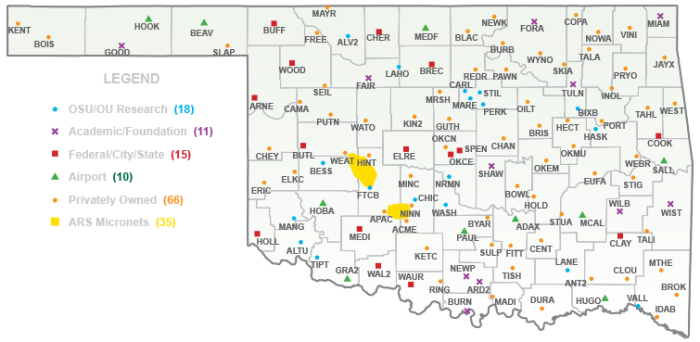
At least one mesonet site is located in each of Oklahoma's 77 counties.


The Oklahoma Mesonet is a statewide environmental monitoring network developed through the cooperative efforts of Oklahoma State University and the University of Oklahoma. The mesonet is a bold, ambitious project to make timely and useful weather information available to the citizens of Oklahoma.
The mesonet consists of 121 CR6-based automated weather stations that continuously measure an array of weather and soil instruments. An additional 35 mesonet-like stations in dense micronets over the Fort Cobb and Little Washita watersheds are funded by the Agricultural Research Service. Each CR6 stores five-minute data summaries and is polled every 5 minutes. Data are relayed from each remote station to a central processing site. This rapid and reliable data transfer is accomplished using a combination of radiotelemetry (RF500M modems), the Oklahoma Law Enforcement Telecommunications System (OLETS—an agency of the Oklahoma Department of Public Safety), and Campbell Scientific’s LoggerNet Datalogger Support Software package.
The central processing site, or base station, is located in the Oklahoma Climatological Survey (OCS) at the National Weather Center in Norman, Oklahoma. The central processing site consists of four instances of LoggerNet Linux for data collection and handling.
The LoggerNet network communication software package provides the operational features associated with two-way communication. This minimizes transmissions required from the central site and allows for real-time communication link status.
Remote operations executable from the central site include:
- Setting the weather station clock
- Downloading weather station programs
- Retrieving stored data following periods of communication failure
- Conditional selecting of alternate reporting intervals or output variables (This feature is especially useful for the mesonet, which collects one-minute observations during tornadic events.)
- Real-time monitoring of instantaneous measurements
The LoggerNet computers collect data from the OLETS high-speed data link, check for any missing reporting stations, and then send the data to an on-line database system over a TCP/IP link. The database checks the data quality, manages data storage, and assists in disseminating the observations and certain value-added products to a statewide community of users—all within minutes of each observation time.
Data is distributed by the OCS via the Oklahoma mesonet website (www.mesonet.org).
A 2009 National Research Council report* named the Oklahoma Mesonet as the “gold standard” for statewide weather and climate networks. The mesonet is unique in its capability to measure a large variety of environmental conditions at so many sites across an area as large as Oklahoma. In addition, these conditions are relayed to a wide variety of customers very quickly after the observations are taken.
* National Research Council, “Observing Weather and Climate from the Ground up: A Nationwide Network of Networks,” Washington, D.C., 2009
Case Study Summary
Application
State-wide environmental monitoring network measuring weather and soil parametersLocation
Oklahoma, USAProducts Used
CR6 CDM-A116 LoggerNet LNLINUX RF500MContributors
Dr. Ken Crawford, Gary Grimsley, Oklahoma Climatological Survey, Norman, OKParticipating Organisations
Oklahoma State University, University of Oklahoma, Oklahoma Climatological SurveyMeasured Parameters
Air and soil temperature, RH, wind speed and direction, barometric pressure, solar radiation, rainfall, soil moistureRelated Website
Oklahoma Mesonet websiteView the PDF